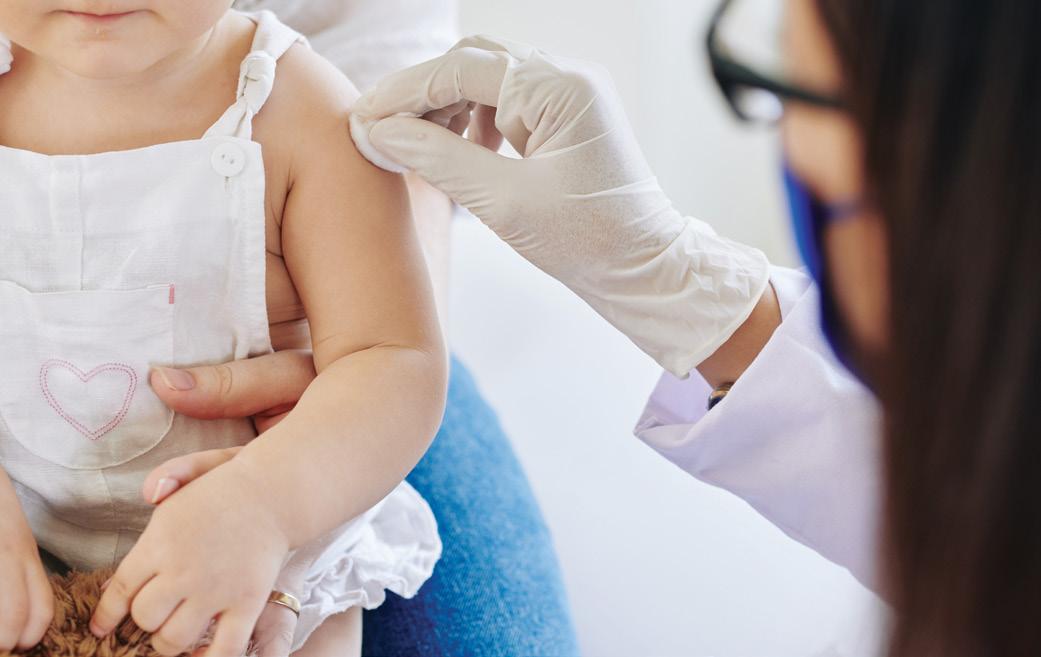What is RSV?
Respiratory syncytial virus, or RSV, is the most common lower respiratory tract infection in infants under age 1. A pediatrician explains what RSV is, its symptoms, treatments, and prevention.
The fall season brings crisp mornings and colorful leaves, but it also marks the beginning of what we call “sick season: for children.” Respiratory Syncytial Virus, commonly referred to as RSV, is one the heavy hitters of the sick season. RSV is a viral infection that affects the smallest, branching tubules of the lungs called bronchioles. When infected, the tubules become swollen and full of mucous making it difficult to breathe.
RSV affects people of all ages, and almost all children are infected by two years of age. In children younger than 1 year, RSV is the most common cause of lower respiratory tract infections(1) and the leading cause of hospitalization(2,3). About 1 to 4 of every 100 infants in the United States is hospitalized for RSV, with approximately 80,000 infant hospitalizations each year(4).

Symptoms
RSV usually begins like a regular cold, with a runny or stuffy nose and mild cough, but then progresses to lower respiratory tract symptoms like wheezing or a deep cough by days 2 or 3. Symptoms usually peak on days 3 to 5, then slowly resolve. Fever and decreased appetite are common in children with RSV.
Children need to see their doctor if they have any of the following symptoms:
- Respiratory distress
- Rapid breathing (tachypnea)
- Pauses between breaths (apnea)
- Nasal flaring
- Retractions – you can see the skin or muscle between your child’s ribs or below their ribcage pull inward
- Trouble eating or drinking
- A fever greater than 100.4°F if your baby is younger than 3 months
- A fever that lasts more than 3 days if your child is older than 3 months
Diagnosis
Testing is available for RSV; however, your child’s doctor can make a diagnosis based on symptoms alone. Sometimes a test is useful if there are other potential causes such as influenza or coronavirus.
Treatment
- Remove as much nasal mucous as possible with either a suction bulb or nasal aspirator.
- Keep your child hydrated with plenty of fluids.
- Use a humidifier.
- Don’t smoke or allow anyone to smoke near your child.
- If your child is older than 6 months, acetaminophen or ibuprofen can be given to relieve fever.
What to Avoid
Some treatments are not recommended and have not been proven to help treat children with RSV, including:
- Cough medications for children under 6 years old
- Antibiotics
- Breathing treatments (inhalers or nebulizers)

Prevention
Vaccines for RSV are on the horizon and have been approved by the FDA in 2023. Even though everyone is infected to RSV by 2 years of age, keep in mind a previous infection does not protect against future infection.
Synagis (palivizumab) is a medication that can help prevent RSV; however, this is reserved for infants born premature or with congenital medical conditions.
- Beyfortus (nirsevimab) is a newly FDA-approved vaccine for RSV in newborns and infants. This is the first preventative option approved to protect a broad infant population including babies born healthy at term or preterm.
- Pfizer’s RSVpreF has also received FDA support. This vaccine would be given to mothers during pregnancy. The vaccine would allow for placental transfer of antibodies that would provide protection during the neonatal period – one of the periods of highest RSV risk during infancy.
- Aresxy is a vaccine recently approved by the FDA and recommended by the CDC for prevention of RSV in adults who are 60 years or older.
Several other RSV vaccines show promise but are still at the stage of research and clinical trials and have not yet been approved by the FDA or CDC.
Sources: 1.) Hall, CB, Weinberg GA, Iwane MK, et al. The burden of respiratory syncytial virus infection in young children. N Engl J Med 2009; 360: 588. | 2.) Leader S, Kohlhase K. Recent trends in severe respiratory syncytial virus among US infants, 1997 to 2000. J Pediatrics. 2003; 143 (5 Suppl): S 127-S132 | 3.) Zhou H, et al. Hospitalization associated with influenza and respiratory syncytial virus in the United States. 1993-2008. Clin Infect Disease. 2012; 54 1427-1436 | 4.) McLaughlin JM, Khan F, et al. Respiratory Syncytial Virus-Associated Hospitalization Rates among US Infants: A Systemic Review and Meta-Analysis. J Infect Dis. 2022 Mar 15; 225(6): 1100-1111.
By Kristin Dietiker, MD; Tiger Pediatrics

Dr. Dietiker is a pediatrician with Tiger Pediatrics and sees patients in Columbia. She is currently accepting new patients.